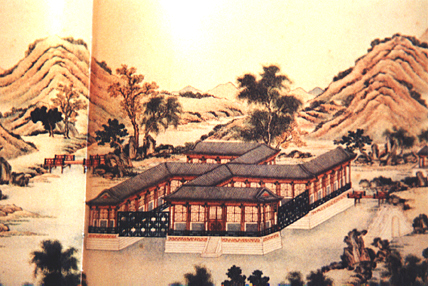萬方安和 ("Tranquillity and peacefulness everywhere") is one of the forty sceneries of Yuan Ming Yuan proper. Built during the
reign of Emperor Yongzhen, this pavilion in the shape of the Buddhist auspicious symbol 卍 was unique
in idea and form. There were 33 rooms. A verandah surrounded the entire building so that one could
stroll around literally in all directions. It is said that the pavilion was Emperor Yongzhen's favourite.
The pavilion was surrounded by water, with at least two bridges connecting it to land. Steps were
also provided so that people could approach it by boat.
, this unique pavilion was reduced to ashes with the rest of Yuan Ming Yuan.
Today, what is left existing is its foundation form.
The Buddhist symbol  is pronounced similarly as the Chinese character
is pronounced similarly as the Chinese character  (wan). In Sanskrit this symbol is called srivatsa.
It denotes the focus of all virtues and auspiciousness. According to authoritative sources (such as 慧琳 《一切經音義》)
, the correct form should be
(wan). In Sanskrit this symbol is called srivatsa.
It denotes the focus of all virtues and auspiciousness. According to authoritative sources (such as 慧琳 《一切經音義》)
, the correct form should be 
.

 is pronounced similarly as the Chinese character
is pronounced similarly as the Chinese character  (wan). In Sanskrit this symbol is called srivatsa.
It denotes the focus of all virtues and auspiciousness. According to authoritative sources (such as 慧琳 《一切經音義》)
, the correct form should be
(wan). In Sanskrit this symbol is called srivatsa.
It denotes the focus of all virtues and auspiciousness. According to authoritative sources (such as 慧琳 《一切經音義》)
, the correct form should be 
